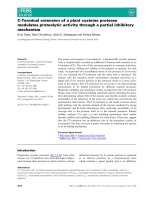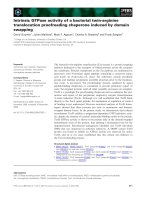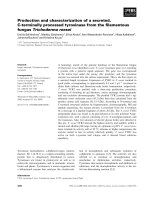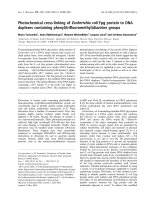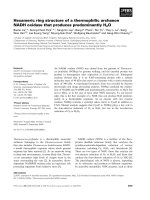Báo cáo khoa học: "Temporal information processing of a new language: fast porting with minimal resources" pdf
Bạn đang xem bản rút gọn của tài liệu. Xem và tải ngay bản đầy đủ của tài liệu tại đây (86.67 KB, 7 trang )
Proceedings of the 48th Annual Meeting of the Association for Computational Linguistics, pages 671–677,
Uppsala, Sweden, 11-16 July 2010.
c
2010 Association for Computational Linguistics
Temporal information processing of a new language:
fast porting with minimal resources
Francisco Costa and Ant
´
onio Branco
Universidade de Lisboa
Abstract
We describe the semi-automatic adapta-
tion of a TimeML annotated corpus from
English to Portuguese, a language for
which TimeML annotated data was not
available yet. In order to validate this
adaptation, we use the obtained data to
replicate some results in the literature that
used the original English data. The fact
that comparable results are obtained indi-
cates that our approach can be used suc-
cessfully to rapidly create semantically an-
notated resources for new languages.
1 Introduction
Temporal information processing is a topic of nat-
ural language processing boosted by recent eval-
uation campaigns like TERN2004,
1
TempEval-1
(Verhagen et al., 2007) and the forthcoming
TempEval-2
2
(Pustejovsky and Verhagen, 2009).
For instance, in the TempEval-1 competition, three
tasks were proposed: a) identifying the temporal
relation (such as overlap, before or after) hold-
ing between events and temporal entities such as
dates, times and temporal durations denoted by ex-
pressions (i.e. temporal expressions) occurring in
the same sentence; b) identifying the temporal re-
lation holding between events expressed in a doc-
ument and its creation time; c) identifying the tem-
poral relation between the main events expressed
by two adjacent sentences.
Supervised machine learning approaches are
pervasive in the tasks of temporal information pro-
cessing. Even when the best performing sys-
tems in these competitions are symbolic, there are
machine learning solutions with results close to
their performance. In TempEval-1, where there
were statistical and rule-based systems, almost
1
2
/>all systems achieved quite similar results. In the
TERN2004 competition (aimed at identifying and
normalizing temporal expressions), a symbolic
system performed best, but since then machine
learning solutions, such as (Ahn et al., 2007), have
appeared that obtain similar results.
These evaluations made available sets of anno-
tated data for English and other languages, used
for training and evaluation. One natural question
to ask is whether it is feasible to adapt the training
and test data made available in these competitions
to other languages, for which no such data still ex-
ist. Since the annotations are largely of a seman-
tic nature, not many changes need to be done in
the annotations once the textual material is trans-
lated. In essence, this would be a fast way to create
temporal information processing systems for lan-
guages for which there are no annotated data yet.
In this paper, we report on an experiment
that consisted in adapting the English data of
TempEval-1 to Portuguese. The results of ma-
chine learning algorithms over the data thus ob-
tained are compared to those reported for the En-
glish TempEval-1 competition. Since the results
are quite similar, this permits to conclude that
such an approach can rapidly generate relevant and
comparable data and is useful when porting tem-
poral information processing solutions to new lan-
guages.
The advantages of adapting an existing corpus
instead of annotating text from scratch are: i)
potentially less time consuming, if it is faster to
translate the original text than it is to annotate
new text (this can be the case if the annotations
are semantic and complex); b) the annotations can
be transposed without substantial modifications,
which is the case if they are semantic in nature;
c) less man power required: text annotation re-
quires multiple annotators in order to guarantee
the quality of the annotation tags, translation of
the markables and transposition of the annotations
671
in principle do not; d) the data obtained are com-
parable to the original data in all respects except
for language: genre, domain, size, style, annota-
tion decisions, etc., which allows for research to
be conducted with a derived corpus that is compa-
rable to research using the original corpus. There
is of course the caveat that the adaptation process
can introduce errors.
This paper proceeds as follows. In Section 2,
we provide a quick overview of the TimeML an-
notations in the TempEval-1 data. In Section 3,
it is described how the data were adapted to Por-
tuguese. Section 4 contains a brief quantitative
comparison of the two corpora. In Section 5, the
results of replicating one of the approaches present
in the TempEval-1 challenge with the Portuguese
data are presented. We conclude this paper in Sec-
tion 6.
2 Brief Description of the Annotations
Figure 1 contains an example of a document from
the TempEval-1 corpus, which is similar to the
TimeBank corpus (Pustejovsky et al., 2003).
In this corpus, event terms are tagged with
<EVENT>. The relevant attributes are tense,
aspect, class, polarity, pos, stem. The
stem is the term’s lemma, and pos is its part-of-
speech. Grammatical tense and aspect are encoded
in the features tense and aspect. The attribute
polarity takes the value NEG if the event term
is in a negative syntactic context, and POS other-
wise. The attribute class contains several lev-
els of information. It makes a distinction between
terms that denote actions of speaking, which take
the value REPORTING and those that do not.
For these, it distinguishes between states (value
STATE) and non-states (value OCCURRENCE),
and it also encodes whether they create an in-
tensional context (value I
STATE for states and
value I
ACTION for non-states).
Temporal expressions (timexes) are inside
<TIMEX3> elements. The most important fea-
tures for these elements are value, type and
mod. The timex’s value encodes a normal-
ized representation of this temporal entity, its
type can be e.g. DATE, TIME or DURATION.
The mod attribute is optional. It is used for ex-
pressions like early this year, which are anno-
tated with mod="START". As can be seen in
Figure 1 there are other attributes for timexes
that encode whether it is the document’s creation
time (functionInDocument) and whether its
value can be determined from the expression
alone or requires other sources of information
(temporalFunction and anchorTimeID).
The <TLINK> elements encode temporal re-
lations. The attribute relType represents the
type of relation, the feature eventID is a ref-
erence to the first argument of the relation.
The second argument is given by the attribute
relatedToTime (if it is a time interval or du-
ration) or relatedToEvent (if it is another
event; this is for task C). The task feature is the
name of the TempEval-1 task to which this tempo-
ral relation pertains.
3 Data Adaptation
We cleaned all TimeML markup in the
TempEval-1 data and the result was fed to
the Google Translator Toolkit.
3
This tool com-
bines machine translation with a translation
memory. A human translator corrected the
proposed translations manually.
After that, we had the three collections of docu-
ments (the TimeML data, the English unannotated
data and the Portuguese unannotated data) aligned
by paragraphs (we just kept the line breaks from
the original collection in the other collections). In
this way, for each paragraph in the Portuguese data
we know all the corresponding TimeML tags in
the original English paragraph.
We tried using machine translation software (we
used GIZA++ (Och and Ney, 2003)) to perform
word alignment on the unannotated texts, which
would have enabled us to transpose the TimeML
annotations automatically. However, word align-
ment algorithms have suboptimal accuracy, so the
results would have to be checked manually. There-
fore we abandoned this idea, and instead we sim-
ply placed the different TimeML markup in the
correct positions manually. This is possible since
the TempEval-1 corpus is not very large. A small
script was developed to place all relevant TimeML
markup at the end of each paragraph in the Por-
tuguese text, and then each tag was manually repo-
sitioned. Note that the <TLINK> elements always
occur at the end of each document, each in a sep-
arate line: therefore they do not need to be reposi-
tioned.
During this manual repositioning of the anno-
tations, some attributes were also changed man-
3
/>672
<?xml version="1.0" ?>
<TempEval>
ABC<TIMEX3 tid="t52" type="DATE" value="1998-01-14" temporalFunction="false"
functionInDocument="CREATION_TIME">19980114</TIMEX3>.1830.0611
NEWS STORY
<s>In Washington <TIMEX3 tid="t53" type="DATE" value="1998-01-14" temporalFunction="true"
functionInDocument="NONE" anchorTimeID="t52">today</TIMEX3>, the Federal Aviation Administration <EVENT
eid="e1" class="OCCURRENCE" stem="release" aspect="NONE" tense="PAST" polarity="POS" pos="VERB">released
</EVENT> air traffic control tapes from <TIMEX3 tid="t54" type="TIME" value="1998-XX-XXTNI"
temporalFunction="true" functionInDocument="NONE" anchorTimeID="t52">the night</TIMEX3> the TWA Flight
eight hundred <EVENT eid="e2" class="OCCURRENCE" stem="go" aspect="NONE" tense="PAST" polarity="POS"
pos="VERB">went</EVENT>down.</s>
<TLINK lid="l1" relType="BEFORE" eventID="e2" relatedToTime="t53" task="A"/>
<TLINK lid="l2" relType="OVERLAP" eventID="e2" relatedToTime="t54" task="A"/>
<TLINK lid="l4" relType="BEFORE" eventID="e2" relatedToTime="t52" task="B"/>
</TempEval>
Figure 1: Extract of a document contained in the training data of the first TempEval-1
ually. In particular, the attributes stem, tense
and aspect of <EVENT> elements are language
specific and needed to be adapted. Sometimes, the
pos attribute also needs to be changed, since e.g.
a verb in English can be translated as a noun in
Portuguese. The attribute class of the same kind
of elements can be different, too, because natural
sounding translations are sometimes not literal.
3.1 Annotation Decisions
When porting the TimeML annotations from En-
glish to Portuguese, a few decisions had to be
made. For illustration purposes, Figure 2 contains
the Portuguese equivalent of the extract presented
in Figure 1.
For <TIMEX3> elements, the issue is that if the
temporal expression to be annotated is a preposi-
tional phrase, the preposition should not be inside
the <TIMEX3> tags according to the TimeML
specification. In the case of Portuguese, this raises
the question of whether to leave contractions of
prepositions with determiners outside these tags
(in the English data the preposition is outside and
the determiner is inside).
4
We chose to leave them
outside, as can be seen in that Figure. In this ex-
ample the prepositional phrase from the night/da
noite is annotated with the English noun phrase
the night inside the <TIMEX3> element, but the
Portuguese version only contains the noun noite
inside those tags.
For <EVENT> elements, some of the attributes
are adapted. The value of the attribute stem is
4
The fact that prepositions are placed outside of temporal
expressions seems odd at first, but this is because in the orig-
inal TimeBank, from which the TempEval data were derived,
they are tagged as <SIGNAL>s. The TempEval-1 data does
not contain <SIGNAL> elements, however.
obviously different in Portuguese. The attributes
aspect and tense have a different set of
possible values in the Portuguese data, simply
because the morphology of the two languages
is different. In the example in Figure 1 the
value PPI for the attribute tense stands for
pret
´
erito perfeito do indicativo. We chose to
include mood information in the tense attribute
because the different tenses of the indicative and
the subjunctive moods do not line up perfectly
as there are more tenses for the indicative than
for the subjunctive. For the aspect attribute,
which encodes grammatical aspect, we only
use the values NONE and PROGRESSIVE,
leaving out the values PERFECTIVE and
PERFECTIVE
PROGRESSIVE, as in Portuguese
there is no easy match between perfective aspect
and grammatical categories.
The attributes of <TIMEX3> elements carry
over to the Portuguese corpus unchanged, and the
<TLINK> elements are taken verbatim from the
original documents.
4 Data Description
The original English data for TempEval-1 are
based on the TimeBank data, and they are split
into one dataset for training and development and
another dataset for evaluation. The full data are or-
ganized in 182 documents (162 documents in the
training data and another 20 in the test data). Each
document is a news report from television broad-
casts or newspapers. A large amount of the doc-
uments (123 in the training set and 12 in the test
data) are taken from a 1989 issue of the Wall Street
Journal.
The training data comprise 162 documents with
673
<?xml version="1.0" encoding="UTF-8" ?>
<TempEval>
ABC<TIMEX3 tid="t52" type="DATE" value="1998-01-14" temporalFunction="false"
functionInDocument="CREATION_TIME">19980114</TIMEX3>.1830.1611
REPORTAGEM
<s>Em Washington, <TIMEX3 tid="t53" type="DATE" value="1998-01-14" temporalFunction="true"
functionInDocument="NONE" anchorTimeID="t52">hoje</TIMEX3>, a Federal Aviation Administration <EVENT
eid="e1" class="OCCURRENCE" stem="publicar" aspect="NONE" tense="PPI" polarity="POS" pos="VERB">publicou
</EVENT> gravaoes do controlo de trfego areo da <TIMEX3 tid="t54" type="TIME" value="1998-XX-XXTNI"
temporalFunction="true" functionInDocument="NONE" anchorTimeID="t52">noite</TIMEX3> em que o voo TWA800
<EVENT eid="e2" class="OCCURRENCE" stem="cair" aspect="NONE" tense="PPI" polarity="POS" pos="VERB">caiu
</EVENT>
.</s>
<TLINK lid="l1" relType="BEFORE" eventID="e2" relatedToTime="t53" task="A"/>
<TLINK lid="l2" relType="OVERLAP" eventID="e2" relatedToTime="t54" task="A"/>
<TLINK lid="l4" relType="BEFORE" eventID="e2" relatedToTime="t52" task="B"/>
</TempEval>
Figure 2: Extract of a document contained in the Portuguese data
2,236 sentences (i.e. 2236 <s> elements) and
52,740 words. It contains 6799 <EVENT> el-
ements, 1,244 <TIMEX3> elements and 5,790
<TLINK> elements. Note that not all the events
are included here: the ones expressed by words
that occur less than 20 times in TimeBank were
removed from the TempEval-1 data.
The test dataset contains 376 sentences and
8,107 words. The number of <EVENT> elements
is 1,103; there are 165 <TIMEX3>s and 758
<TLINK>s.
The Portuguese data of course contain the same
(translated) documents. The training dataset has
2,280 sentences and 60,781 words. The test data
contains 351 sentences and 8,920 words.
5 Comparing the two Datasets
One of the systems participating in the
TempEval-1 competition, the USFD system
(Hepple et al., 2007), implemented a very
straightforward solution: it simply trained classi-
fiers with Weka (Witten and Frank, 2005), using
as attributes information that was readily available
in the data and did not require any extra natural
language processing (for all tasks, the attribute
relType of <TLINK> elements is unknown and
must be discovered, but all the other information
is given).
The authors’ objectives were to see “whether a
‘lite’ approach of this kind could yield reasonable
performance, before pursuing possibilities that re-
lied on ‘deeper’ NLP analysis methods”, “which
of the features would contribute positively to sys-
tem performance” and “if any [machine learning]
approach was better suited to the TempEval tasks
than any other”. In spite of its simplicity, they ob-
tained results quite close to the best systems.
For us, the results of (Hepple et al., 2007) are in-
teresting as they allow for a straightforward evalu-
ation of our adaptation efforts, since the same ma-
chine learning implementations can be used with
the Portuguese data, and then compared to their
results.
The differences in the data are mostly due to
language. Since the languages are different, the
distribution of the values of several attributes are
different. For instance, we included both tense
and mood information in the tense attribute of
<EVENT>s, as mentioned in Section 3.1, so in-
stead of seven possible values for this attribute, the
Portuguese data contains more values, which can
cause more data sparseness. Other attributes af-
fected by language differences are aspect, pos,
and class, which were also possibly changed
during the adaptation process.
One important difference between the English
and the Portuguese data originates from the fact
that events with a frequency lower than 20 were
removed from the English TempEval-1 data. Since
there is not a 1 to 1 relation between English event
terms and Portuguese event terms, we do not have
the guarantee that all event terms in the Portuguese
data have a frequency of at least 20 occurrences in
the entire corpus.
5
The work of (Hepple et al., 2007) reports on
both cross-validation results for various classifiers
over the training data and evaluation results on the
training data, for the English dataset. We we will
5
In fact, out of 1,649 different stems for event terms in the
Portuguese training data, only 45 occur at least 20 times.
674
Task
Attribute A B C
EVENT-aspect
EVENT-polarity ×
EVENT-POS
EVENT-stem × ×
EVENT-string × × ×
EVENT-class ×
EVENT-tense ×
ORDER-adjacent N/A N/A
ORDER-event-first N/A N/A
ORDER-event-between × N/A N/A
ORDER-timex-between × N/A N/A
TIMEX3-mod × N/A
TIMEX3-type × N/A
Table 1: Features used for the English TempEval-1
tasks. N/A means the feature was not applicable to
the task,
means the feature was used by the best
performing classifier for the task, and × means it
was not used by that classifier. From (Hepple et
al., 2007).
be comparing their results to ours.
Our purpose with this comparison is to validate
the corpus adaptation. Similar results would not
necessarily indicate the quality of the adapted cor-
pus. After all, a word-by-word translation would
produce data that would yield similar results, but
it would also be a very poor translation, and there-
fore the resulting corpus would not be very inter-
esting. The quality of the translation is not at stake
here, since it was manually revised. But similar
results would indicate that the obtained data are
comparable to the original data, and that they are
similarly useful to tackle the problem for which
the original data were collected. This would con-
firm our hypothesis that adapting an existing cor-
pus can be an effective way to obtain new data for
a different language.
5.1 Results for English
The attributes employed for English by (Hepple et
al., 2007) are summarized in Table 1. The class is
the attribute relType of <TLINK> elements.
The EVENT features are taken from <EVENT>
elements. The EVENT-string attribute is the
character data inside the element. The other at-
tributes correspond to the feature of <EVENT>
with the same name. The TIMEX3 features
Task
Algorithm A B C
baseline 49.8 62.1 42.0
lazy.KStar 58.2 76.7 54.0
rules.DecisionTable 53.3 79.0 52.9
functions.SMO 55.1 78.1 55.5
rules.JRip 50.7 78.6 53.4
bayes.NaiveBayes 56.3 76.2 50.7
Table 2: Performance of several machine learn-
ing algorithms on the English TempEval-1 train-
ing data, with cross-validation. The best result
for each task is in boldface. From (Hepple et al.,
2007).
also correspond to attributes of the relevant
<TIMEX3> element. The ORDER features are
boolean and computed as follows:
• ORDER-event-first is whether the
<EVENT> element occurs in the text before
the <TIMEX3> element;
• ORDER-event-between is whether an
<EVENT> element occurs in the text between
the two temporal entities being ordered;
• ORDER-timex-between is the same, but
for temporal expressions;
• ORDER-adjacent is whether both
ORDER-event-between and ORDER-
timex-between are false (but other
textual data may occur between the two
entities).
Cross-validation over the training data pro-
duced the results in Table 2. The base-
line used is the majority class baseline, as
given by Weka’s rules.ZeroR implemen-
tation. The lazy.KStar algorithm is a
nearest-neighbor classifier that uses an entropy-
based measure to compute instance similarity.
Weka’s rules.DecisionTable algorithm as-
signs to an unknown instance the majority class
of the training examples that have the same
attribute values as that instance that is be-
ing classified. functions.SMO is an imple-
mentation of Support Vector Machines (SVM),
rules.JRip is the RIPPER algorithm, and
bayes.NaiveBayes is a Naive Bayes classi-
fier.
675
Task
Algorithm A B C
baseline 49.8 62.1 42.0
lazy.KStar 57.4 77.7 53.3
rules.DecisionTable 54.2 78.1 51.6
functions.SMO 55.5 79.3 56.8
rules.JRip 52.1 77.6 52.1
bayes.NaiveBayes 56.0 78.2 53.5
trees.J48 55.6 79.0 59.3
Table 3: Performance of several machine learn-
ing algorithms on the Portuguese data for the
TempEval-1 tasks. The best result for each task
is in boldface.
5.2 Attributes
We created a small script to convert the XML an-
notated files into CSV files, that can be read by
Weka. In this process, we included the same at-
tributes as the USFD authors used for English.
For task C, (Hepple et al., 2007) are not very
clear whether the EVENT attributes used were re-
lated to just one of the two events being temporally
related. In any case, we used two of each of the
EVENT attributes, one for each event in the tempo-
ral relation to be determined. So, for instance, an
extra attribute EVENT2-tense is where the tense
of the second event in the temporal relation is kept.
5.3 Results
The majority class baselines produce the same
results as for English. This was expected: the
class distribution is the same in the two datasets,
since the <TLINK> elements were copied to the
adapted corpus without any changes.
For the sake of comparison, we used the same
classifiers as (Hepple et al., 2007), and we used the
attributes that they found to work best for English
(presented above in Table 1). The results for the
Portuguese dataset are in Table 3, using 10-fold
cross-validation on the training data.
We also present the results for Weka’s imple-
mentation of the C4.5 algorithm, to induce deci-
sion trees. The motivation to run this algorithm
over these data is that decision trees are human
readable and make it easy to inspect what deci-
sions the classifier is making. This is also true of
rules.JRip. The results for the decision trees
are in this table, too.
The results obtained are almost identical to the
results for the original dataset in English. The best
performing classifier for task A is the same as for
English. For task B, Weka’s functions.SMO
produced better results with the Portuguese data
than rules.DecisionTable, the best per-
forming classifier with the English data for this
task. In task C, the SVM algorithm was also the
best performing algorithm among those that were
also tried on the English data, but decision trees
produced even better results here.
For English, the best performing classifier for
each task on the training data, according to Ta-
ble 2, was used for evaluation on the test data: the
results showed a 59% F-measure for task A, 73%
for task B, and 54% for task C.
Similarly, we also evaluated the best algorithm
for each task (according to Table 3) with the Por-
tuguese test data, after training it on the entire
training dataset. The results are: in task A the
lazy.KStar classifier scored 58.6%, and the
SVM classifier scored 75.5% in task B and 59.4%
in task C, with trees.J48 scoring 61% in this
task.
The results on the test data are also fairly similar
for the two languages/datasets.
We inspected the decision trees and rule sets
produced by trees.J48 and rules.JRip, in
order to see what the classifiers are doing.
Task B is probably the easiest task to check this
way, because we expect grammatical tense to be
highly predictive of the temporal order between an
event and the document’s creation time.
And, indeed, the top of the tree induced by
trees.J48 is quite interesting:
eTense = PI: OVERLAP (388.0/95.0)
eTense = PPI: BEFORE (1051.0/41.0)
Here, eTense is the EVENT-tense attribute
of <EVENT> elements, PI stands for present in-
dicative, and PPI is past indicative (pret
´
erito per-
feito do indicativo). In general, one sees past
tenses associated with the BEFORE class and fu-
ture tenses associated with the AFTER class (in-
cluding the conditional forms of verbs). Infini-
tives are mostly associated with the AFTER class,
and present subjunctive forms with AFTER and
OVERLAP. Figure 3 shows the rule set induced by
the RIPPER algorithm.
The classifiers for the other tasks are more dif-
ficult to inspect. For instance, in task A, the event
term and the temporal expression that denote the
entities that are to be ordered may not even be di-
rectly syntactically related. Therefore, it is hard to
676
(eClass = OCCURRENCE) and ( eTense = INF) and ( ePolarity = POS) => lRelType= AFTER
(183.0/77.0)
( eTense = FI) => lRelType= AFTER (55.0/10.0)
(eClass = OCCURRENCE) and ( eTense = IR-PI+INF) => lRelType= AFTER (26.0/4.0)
(eClass = OCCURRENCE) and ( eTense = PC) => lRelType= AFTER (15.0/3.0)
(eClass = OCCURRENCE) and ( eTense = C) => lRelType= AFTER (17.0/2.0)
( eTense = PI) => lRelType= OVERLAP (388.0/95.0)
(eClass = ASPECTUAL) and ( eTense = PC) => lRelType= OVERLAP (9.0/2.0)
=> lRelType= BEFORE (1863.0/373.0)
Figure 3: rules.JRip classifier induced for task B. INF stands for infinitive, FI is future indicative,
IR-PI+INF is an infinitive form following a present indicative form of the verb ir (to go), PC is present
subjunctive, C is conditional, PI is present indicative.
see how interesting the inferred rules are, because
we do not know what would be interesting in this
scenario. In any case, the top of the induced tree
for task A is:
oAdjacent = True: OVERLAP (554.0/128.0)
Here, oAdjacent is the ORDER-adjacent
attribute. Assuming this attribute is an indication
that the event term and the temporal expression are
related syntactically, it is interesting to see that the
typical temporal relation between the two entities
in this case is an OVERLAP relation. The rest of
the tree is much more ad-hoc, making frequent use
of the stem attribute of <EVENT> elements, sug-
gesting the classifier is memorizing the data.
Task C, where two events are to be ordered, pro-
duced more complicated classifiers. Generally the
induced rules and the tree paths compare the tense
and the class of the two event terms, showing some
expected heuristics (such as, if the tense of the first
event is future and the tense of the second event
is past, assign AFTER). But there are also many
several rules for which we do not have clear intu-
itions.
6 Discussion
In this paper, we described the semi-automatic
adaptation of a TimeML annotated corpus from
English to Portuguese, a language for which
TimeML annotated data was not available yet.
Because most of the TimeML annotations are
semantic in nature, they can be transposed to a
translation of the original corpus, with few adap-
tations being required.
In order to validate this adaptation, we used the
obtained data to replicate some results in the liter-
ature that used the original English data.
The results for the Portuguese data are very sim-
ilar to the ones for English. This indicates that our
approach to adapt existing annotated data to a dif-
ferent language is fruitful.
References
David Ahn, Joris van Rantwijk, and Maarten de Ri-
jke. 2007. A cascaded machine learning approach
to interpreting temporal expressions. In Human
Language Technologies 2007: The Conference of
the North American Chapter of the Association for
Computational Linguistics; Proceedings of the Main
Conference, pages 420–427, Rochester, New York,
April. Association for Computational Linguistics.
Mark Hepple, Andrea Setzer, and Rob Gaizauskas.
2007. USFD: Preliminary exploration of fea-
tures and classifiers for the TempEval-2007 tasks.
In Proceedings of SemEval-2007, pages 484–487,
Prague, Czech Republic. Association for Computa-
tional Linguistics.
Franz Josef Och and Hermann Ney. 2003. A sys-
tematic comparison of various statistical alignment
models. Computational Linguistics, 29(1):19–51.
James Pustejovsky and Marc Verhagen. 2009.
Semeval-2010 task 13: evaluating events, time ex-
pressions, and temporal relations (tempeval-2). In
Proceedings of the Workshop on Semantic Evalua-
tions: Recent Achievements and Future Directions,
pages 112–116, Boulder, Colorado. Association for
Computational Linguistics.
James Pustejovsky, Patrick Hanks, Roser Saur´ı, An-
drew See, Robert Gaizauskas, Andrea Setzer,
Dragomir Radev, Beth Sundheim, David Day, Lisa
Ferro, and Marcia Lazo. 2003. The TIMEBANK
corpus. In Proceedings of Corpus Linguistics 2003,
pages 647–656.
M. Verhagen, R. Gaizauskas, F. Schilder, M. Hepple,
and J. Pustejovsky. 2007. SemEval-2007 Task 15:
TempEval temporal relation identification. In Pro-
ceedings of SemEval-2007.
Ian H. Witten and Eibe Frank. 2005. Data Mining:
Practical Machine Learning Tools and Techniques
with Java Implementations. Morgan Kaufmann, San
Francisco. second edition.
677
